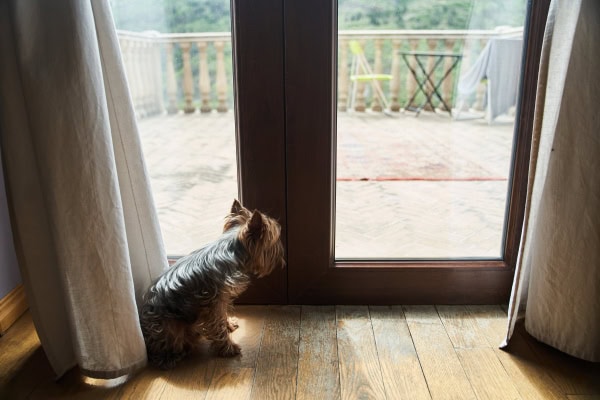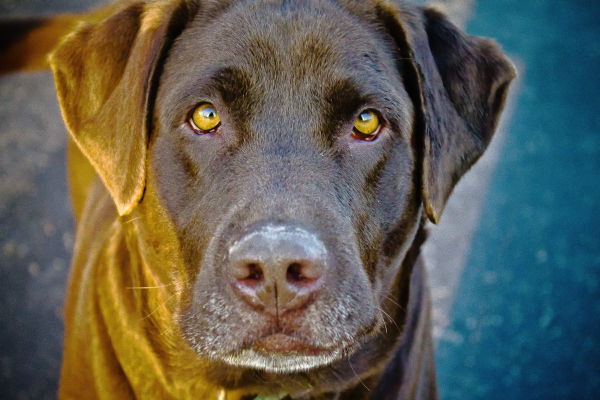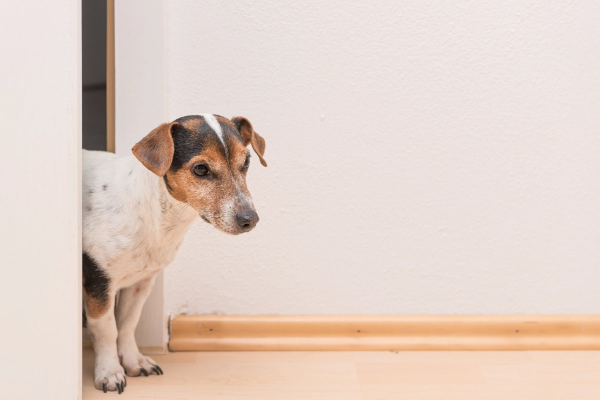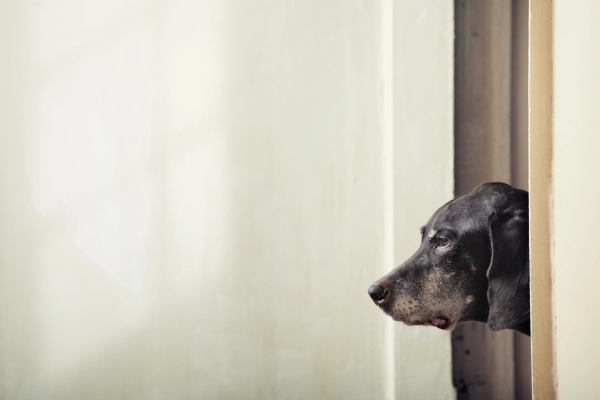When a dog is staring at the wall or staring into space, there are a variety of possible explanations. Integrative veterinarian Dr. Julie Buzby discusses 10 reasons for a dog standing and staring. Plus, learn when to go to the vet and what information to bring to the visit.

Have you ever noticed your dog staring into space or staring at the wall? Sometimes this happens when your dog is intently trying to locate the source of a new sound or smell. But especially in senior dogs, staring into space or staring at the wall can also be a sign of a bigger problem that requires veterinary attention.
So how do you know what is normal and what isn’t?
Why is my dog staring at the wall?
To give you a better idea of why your dog might be staring at the wall or staring into space, let’s take a look at 10 possible explanations.
#1: Focusing on a scent or sound
Dogs have an extraordinary sense of smell and hearing. And many times, they can smell, see, or hear something that we can’t. So, if your dog is staring at the wall or a particular spot, this could be a normal behavior.
When your dog is listening or smelling intently, you may notice that he or she:
- Jumps up suddenly
- Stands up straighter
- Moves closer to a wall or other area of interest
- Raises the fur along his or her neck and back (the hackles)
- Cocks his or her head to the side
- Perks his or her ears up
- Licks the air and/or the nose to enhance scent detection
If you are seeing these behaviors and they just happen periodically, it is possible that your canine companion is simply engaging his or her senses. In this case, you should be able to distract your dog from staring by calling his or her name or by offering a toy. And your dog will otherwise be acting totally normal before, during, and after the staring episode.
However, if you are noticing that your dog is showing other strange behaviors, you can’t get his or her attention, or the standing and staring episodes are happening frequently, the staring may not be normal.
#2: Trying to get your attention (e.g. for food or a walk)
The other normal reason that a dog might stand and stare is if they are trying to get attention from you or want you to do something. However, in this case, they are most likely staring at you or staring at the food bowl, door, leash, or other object that represents what they want. They probably aren’t staring into space with a blank look or staring at the wall.

#3: Canine cognitive dysfunction (doggy dementia)
One of the most common abnormal reasons for a dog staring at a wall or standing in a corner is canine cognitive dysfunction (CCD). Canine cognitive dysfunction or doggy dementia is very similar to Alzheimer’s in humans. It becomes increasingly prevalent as dogs move through their senior years.
With CCD, older dogs begin to experience cognitive decline due to changes in the brain. Some of the most common signs of dementia in dogs include:
- Increasing anxiety (generalized or separation anxiety)
- Being less interested in interacting with you or other family members
- Acting lethargic or uninterested in participating in favorite activities
- Staring at walls or getting stuck in corners
- Whining and pacing (especially at night, which is why CCD is also called sundowners in dogs)
- Barking at nothing (especially at dusk or night)
- Appearing disoriented
- Acting like they forgot the location of furniture, the food dish, or other common items
- Having accidents in the house due to no longer being house trained
- Experiencing changes in sleep-wake cycles
If this sounds like your dog, you may want to fill out a canine cognitive dysfunction checklist to better identify his or her signs of cognitive dysfunction. Then talk to your veterinarian about what you are seeing at home. Unfortunately, CCD isn’t curable, but there are still ways to help your dog.
Mental stimulation toys and games for dogs can help improve brain health. Plus, your veterinarian can prescribe medications such as selegiline for dogs to help manage the symptoms. Or he or she might recommend brain-boosting supplements like Dr. Buzby’s Brain Boost™ organic MCT oil for dogs or specialized foods like Hill’s® Prescription Diet® b/d and Purina® NeuroCare.

#4: Seizures
Seizures are another of the most common reasons why dogs might stare at a wall or stare into space. You may think of seizures in dogs as an event where the dog gets stiff, falls over, and starts convulsing.
However, dogs can also have less dramatic seizure events. They may just have some twitching of the muscles of the face and the eyes or show fly biting behavior (where the dog bites the air as though catching a fly). Some dogs may lay down and tremble a little or urinate and defecate. And other dogs may stare at the wall, shake, and appear to be unresponsive.
Thus, it could be possible that your dog is staring at the wall because he or she is having a seizure.
If possible, try to get a video of the suspected seizure so your vet can see what happened. You also should call your veterinarian right away to set up an appointment for your dog. Remember though, that multiple seizures back-to-back or seizures that appear to be getting worse require prompt medical attention. In that situation, please make an emergency vet visit rather than waiting for a regular appointment with your vet.
There are many different causes of seizures. This makes it important to work with your vet to determine the underlying cause and develop a treatment plan. Some dogs with idiopathic epilepsy don’t need any treatment at all if the seizures are mild and infrequent. Others may need anti-convulsant medications like phenobarbital or zonisamide for dogs for the remainder of their lives. Or the dog may need treatment for the specific condition (e.g. toxin ingestion like xylitol for dogs) causing the seizures.
Additionally, it is worth noting that dogs with seizures may benefit from MCT oil just like dogs with dementia.
#5: Brain tumors
Brain tumors in dogs may cause seizures, but they also can cause your dog to stare at the wall or into space. In addition to seizures and staring, some of the common symptoms of brain tumors in dogs include:
- Behavior changes
- Not recognizing people or other pets who are familiar to them
- Sleeping more
- Appearing off-balance or weak
- Drooping of the face
Brain tumors can affect each dog differently depending on the type and location of the tumor. Thus, the list above is far from exhaustive. If your dog is staring into space and has other concerning symptoms, it is important to consult your veterinarian. If he or she suspects a brain tumor, your vet can refer you to a veterinary specialist near you for specialized imaging (MRI or CT) to diagnose the tumor.
Then you can discuss the treatment plan with a veterinary oncologist. Depending on the situation, treatment of a brain tumor may involve radiation, chemotherapy, surgery, and/or medications to attempt to improve quality of life.

#6: Other conditions affecting the brain or spinal cord
If you notice your dog staring at nothing and exhibiting some of the symptoms listed for a brain tumor, it is possible that your dog could also have a different condition that affects the brain or spinal cord. Some other neurological conditions in dogs that might cause your dog to stand and stare at the wall include:
- Hepatic encephalopathy in dogs—In cases of severe liver disease in dogs, toxins that the liver would normally remove from the body may build up in the bloodstream. They can go to the brain and lead to hepatic encephalopathy, which is essentially neurologic symptoms like seizures, wobbly gait, or staring that occur due to a problem with the liver.
- Inflammation of the nervous system—Encephalitis (brain inflammation), meningitis (inflammation of the meninges, which cover the brain and spinal cord), myelitis (inflammation of the spinal cord) or meningoencephalomyelitis (inflammation of the brain, spinal cord, and meninges) can also cause your dog to stand and stare or show other neurologic symptoms. For example, granulomatous meningoencephalomyelitis (GME in dogs) can cause a variety of neurologic symptoms including staring at the wall.
- Stroke—Strokes in dogs, or disruption of blood flow in the brain, are far less common in dogs than they are in people. However, they do occur, and could cause your dog to be disoriented or stare into space.
These conditions can have similar symptoms. Thus, it’s important to work with your vet to determine what exactly is causing your dog to stare into space.
#7. Compulsive disorder
On the other hand, your dog could be staring at the wall because of a behavioral condition such as canine compulsive disorder. In this condition, the dog engages in compulsive behavior. In other words, he or she performs a behavior repeatedly with no apparent cause. It is often very difficult to distract the dog and stop him or her from doing the compulsive behavior.
Sometimes compulsive behaviors are normal actions that are done to excess. For example, grooming is normal for a dog to do. But if he or she is licking or continuously biting at the skin and there is no underlying cause (e.g. allergies, signs your dog has fleas, etc.), the dog could be performing a compulsive behavior.
A few of the more common compulsive behaviors include:
- Staring at a wall or object even though nothing is there
- Chasing objects that don’t exist
- Pacing back and forth, sometimes in the same spot
- Barking at nothing
- Digging
- Circling excessively
- Running the border of a fence non-stop
- Biting the air or a dog licking the air
- Chewing/sucking on the flank or back leg
- Drinking water excessively
- Chewing on blankets or other objects
Some dogs may exhibit only one behavior like staring into space, but other dogs may show multiple behaviors. Because some of these behaviors can be associated with other conditions, it is important to consult your veterinarian for a full work-up. He or she can help you distinguish between compulsive behaviors and behaviors that are the result of a medical problem.
If your vet diagnoses your dog with compulsive disorder, he or she may recommend medications, supplements, training exercises, and/or working with veterinary behaviorists or dog trainers. All of these tactics can help reduce your dog’s obsessive behavior.
#8. Anxiety
Similar to compulsive behaviors, anxiety may also cause dogs to stare at walls. Any breed or age of dog can develop anxiety. And it can show up later in life even if the dog never had anxiety previously.
Some signs of anxiety include:
- Standing and staring
- Whining
- Pacing
- Destroying things in the house
- Barking excessively
- Panting
- Drooling
- Hiding or trying to escape
- Having a tense body and wide eyes
Additionally, some dogs with anxiety may also exhibit compulsive behaviors.

Anxiety can worsen over time if it is not managed appropriately—especially if there are specific triggers in the dog’s environment that do not go away. It can be helpful to take note of which situations seem to be the most anxiety-provoking for your dog. Then work with your veterinarian or a veterinary behaviorist to find medications, supplements, and strategies to decrease your dog’s anxiety.
#9: Vision loss
As your dog ages, his or her vision may start to fade away, leaving your senior pup partially or completely blind. Or your dog could develop cataracts in dogs, glaucoma in dogs, sudden acquired retinal degeneration syndrome (SARDS in dogs), or another sight-stealing condition.
In all these situations, you may find your dog starting to stare at the wall or stare into space because he or she can’t see anymore. Plus, blind dogs or those with low vision may also bump into objects or be reluctant to move.
Unfortunately, more often than not, vision loss is irreversible. But the good news is that blind dogs can learn to navigate their environment and continue to live a joyful life.
#10: Lethargy and depression
Staring at a wall could also be a general indication that your dog isn’t feeling well.
Some lethargic dogs or those experiencing depression or pain may choose to stare into space due to their lack of interest in any other behaviors or play activities. Or the dog may be too tired or weak to change positions and stop staring at the wall.
Thus, if your dog seems to be staring at the wall for a long time or suddenly starts staring at the wall frequently, it may be worth a trip to the veterinarian. This is especially the case if you are noticing other symptoms of feeling sick such as weakness, changes in appetite or thirst, weight gain or loss, coughing, vomiting, or changes in urination or defecation.
How can you help the vet find the reason your dog is staring at the wall or staring into space?
If your dog is staring at the wall or staring at nothing and you are worried about him or her, please make an appointment with your vet. In preparation for the visit, it can be helpful to take note of what else is going on with your dog and his or her environment during the time your dog is staring. Plus, you may want to video an episode so your vet can see what is happening.
Useful questions to ask yourself include:
- Is your dog standing and staring at nothing at night, during the day, or both?
- Did something scare your dog?
- Was he or she overly excited about anything?
- Was your dog shaking or trembling?
- Did you notice your dog having any abnormal eye movement or muscle spasms?
- Did your dog recognize you or seem to hear you say his or her name?
- Is your dog whining or whimpering?
- Did your dog appear to get weak or fall over?
- Did your dog urinate or defecate?
- Did the staring at the wall appear to be triggered by anything?
- Is your dog head pressing (putting his or her head in a corner or against an item and pushing against it)?
Rather than just answering in your head, you may want to write down the answers as well as general observations about your dog in a journal or somewhere on your phone. That way, when the vet is asking questions during the exam, you already have the information in front of you.
Work with your vet
As you have learned, some reasons for a dog staring at the wall or staring into space are no big deal. But others can be more serious. Therefore, if you have noticed an increase in staring behavior in your dog (and potentially other symptoms too), the best thing you can do is make an appointment with your veterinarian. Together, you can get to the bottom of why your dog is staring abnormally and put a plan in place to help him or her feel better.
Why was your dog staring at the wall?
Please comment below.


Bear began to do this after he went blind, very quickly, due to diabetes. He is getting a little, very little, better about maneuvering the house but he’s been here 10 years and I thought would know where to go, so maybe this is also some cognitive decline.
However, would cognitive decline happen that fast? He only started doing that last week when he suddenly, within a day, began to show the signs of being completely blind. Before that, he had some vision impairment but still could see to go to his bowl and see when we go potty, for walks, etc.
So it seems it would be all vision related. That and depression and he feels poorly. His glucose according to the Libre 3 averages, continually, at 401.
It would be hard to imagine he’d suddenly have doggy dementia that came on in days – but with the speed this diabetes has taken his dignity, his sight, his energy, his ability to walk the lake other than a slow plod, nothing about diabetes would surprise me now.
Hi Kathryn,
I know you are very worried about Bear with the recent changes to his health and behavior. While the diabetes may be the main culprit behind these issues, it is possible for dementia to progress very quickly especially when other problems arise (such as blindness). Please know I continue to pray for you both. Wishing you strength and peace as you navigate this emotional path.
Thank you so much and so very kindly, Dr. Buzby.. You are truly a treasure. You bring comfort to so many pet owners who are struggling and worried and sad and frustrated and often exhausted.
After crying and sobbing so many days since this diagnosis, I realized I was not enjoying my sweet little guy but already mourning his death before it was even here! I have altered our schedule to make it less exhausting and stressful on us both, I took a breath and gave myself permission not to be perfect and SuperWoman, and I changed my attitude to one where I will hug and cuddle Bear and enjoy whatever time I have left. As I am fairly sure we won’t be able to regulate his numbers but who knows what time he has!.
Thank you!